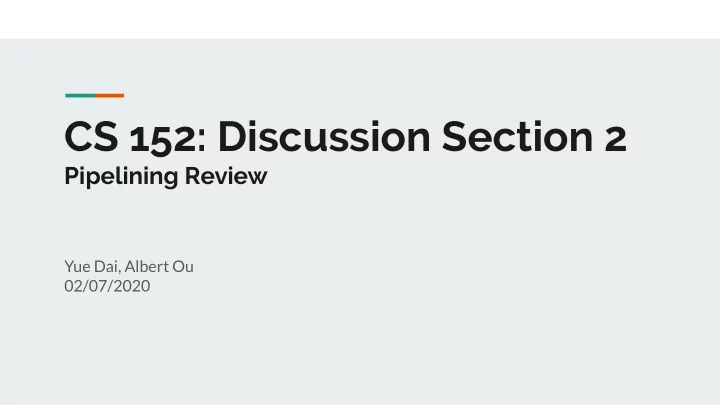

CS 152: Discussion Section 2 Pipelining Review Yue Dai, Albert Ou 02/07/2020
Administrivia PS1 due on Monday 10:30am ; solutions will be released next Friday ● PS2 will be released next Wednesday ● Lab 1 due on Wednesday, Feb 19th ●
Agenda Iron Law ● Pipelining ● Hazards ○ Pipeline operation ○ Alternative pipeline organizations ○ Exceptions ●
Iron Law (Important!) Q: List three different techniques to improve each term.
Iron Law Case 1: In a classic RISC pipeline, modifying the ISA (and thus the microarchitecture) to use hardware interlocking instead of software interlocking for both branch delay slots and load-use delay slots. [Quiz 1, 2011] Instruction/program: CPI: Cycle Time:
Iron Law Case 2: Remove hardware floating-point instructions and instead use software subroutines for floating-point arithmetic. [Quiz 1, 2013] Instruction/program: CPI: Cycle Time:
Pipeline - Hazard Structural hazard ● Q: Are there any structural hazards in a classic 5-stage RISC pipeline? ○ Q: What modifications to the pipeline may introduce a structure hazard? ○ Data hazard ● Control hazard ●
Pipeline - Data Hazard Read-After-Write (RAW) ● ADD x1, x2, x3 SW x4, 4(x1) Write-After-Read (WAR) ● ADD x1, x2, x3 SUB x2, x4, x5 Write-After-Write (WAW) ● ADD x1, x2, x3 SUB x1, x4, x5 Q: Why is RAW the only true dependency in a classic 5-stage RISC pipeline?
Pipeline - Exercise Label all data hazards: ADDI x1, x0, 4 SW x1, 8(x2) SLLI x3, x1, 1 ADD x3, x2, x3 LW x1, 0(x3)
Pipeline - Exercise Q: What does the following code do? How many iterations does it run? 0x400: 0x0 Memory: 0x404: 0xD40 ... ADD x1, x0, x0 0x800: 0x9F0 ADDI x2, x0, 0x800 0x804: 0x400 LOOP: LW x2, 4(x2) … ADD x1, x2, x1 0x9F0: 0x400 0x9F4: 0x0 BNEQ x2, x0, LOOP … 0xD40: 0x0 0xD44: 0x9F0
Pipeline - Classic RISC (Load-Use Interlock) Fill in pipeline diagram (What is the branch penalty?)
Pipeline - Pointer Chasing Example Q: For the prior code and pipeline what is the CPI? (CPI is measured from when first instruction commits to when last instruction in the sequence commits) Q: Give an expression for CPI for K iterations. Q: What is the CPI with perfect branch prediction?
Pipeline - Impact after Modification Q: How does CPI change if we split M into M1 and M2? Q: How does CPI change when the M stage is made to be N stages long?
Pipeline - Address Generation Interlock Fill in pipeline diagram From: Golden and Mudge, A comparison of two pipeline organizations (1994)
Pipeline - AGI vs LUI Q: What is the CPI for this pipeline (AGI-2)? Q: How does CPI change when there is only one MEM stage? Q: How does CPI change when there are N MEM stages?
Pipeline - Apply Iron Law Suppose the classic RISC pipeline closes timing at 1 GHz. Q: (For this application), at what frequency does the AGI-2 pipeline perform better? (Assume perfect branch prediction) Q: AGI-N vs LUI-N?
Exceptions Precise Exception Definition: All instructions prior to the exception in program order have committed, and none of the instructions after (and including the faulting instruction) appear to have started. Q: Why are precise exceptions useful? Q: Why might one not want to always implement precise exceptions?
Exception Handling in RISC-V (M-mode) Example: Misaligned address exception on a load 1. MEPC ( exception PC) ← PC of the load instruction 2. MCAUSE ( exception cause ) ← 0x4 (i.e., load address misaligned) 3. MTVAL ← Exception-specific metadata (i.e., faulting address) 4. MPP ← Previous privilege mode 5. MPIE ← MIE; MIE ← 0: Disable interrupts (and save the previous value) 6. PC ← MTVEC ( trap vector ) This all happens atomically - why?
In the Exception Handler Preserve context ● Swap stack pointer (x1) with MSCRATCH CSR (pointer to M-mode stack) ○ Spill as many registers as needed to memory ○ Decode exception cause, dispatch to correct handler ● Emulate unaligned load ● Issue two aligned loads and combine them together ○ Write result to the entry for rd in the saved register context ○ Restore registers ● Read old register values back from the stack ○ Swap MSCRATCH to restore original stack pointer ○ 19
Exception Return Increment EPC ● In this case, the instruction has been emulated, so no need to re-execute! ○ Execute MRET to return to previous privilege mode in MPP field ● PC ← MEPC ○ MIE ← MPIE ○ 20
Recommend
More recommend